 |
The physical requirements for Chen-Style Tai Chi Practical Method (陈式太极拳实用拳法), a distinct martial art with unique training methods, have been summarized by Master Chen Zhonghua.
Translation of Master Chen Zhonghua Structural or Component Requirements in the Practical Method in 2012 (In Chinese only) |
Knowledge : Principle-Concept
 |
Chen-Style Tai Chi Practical Method (陈式太极拳实用拳法) is a unique martial art with a lineage tracing back to Master Chen FaKe (陳發科 1887-1957) and Master Hong Junsheng (洪均生 1907-1996). Over time, this style has developed specialized terminology and nomenclature to convey its principles and training methods. Master Chen Zhonghua (陈中华 1961– ), drawing upon decades of teaching experience and professional training in linguistics, introduces these terms to a Western audience. The following definitions clarify key terms used within the Practical Method.
Translation of Master Chen Zhonghua list of definitions in the Practical Method in 2012 (In Chinese only) |
The Tai Ji state we are talking about has two parts. One part is concrete, and the other part is abstract. Both are real, not imaginary.

The first part is concrete, mainly in these three aspects of structure, energy alignment and speed. The abstract part is the overall coordinated structure, please refer to the article of Mr. Sun Zhonghua linked at the end of this article.
In terms of structure, the foundations and forms of our Taiji (the author analyzes based on Chen Style Taijiquan Practical Method and Hunyuan Taiji) are different from those of other styles. Some of these differences are external, but subtle and difficult to detect. Some are internal and even more difficult to see.

Grandmaster Feng Zhiqiang
All martial arts styles require balance in movement and structure, but external martial arts can achieve balance with power. Taijiquan strictly requires balance to be achieved without external force as much as possible. Therefore, this style can be practiced in the same way until old age.
The special requirements of Taiji structure are even more stringent on angles. This requirement forces practitioners to make principled adjustments (re-calibrations) to every part of the body. One result of this is that one aspect of Tai Ji Kung Fu comes from the concept of two-point alignment. Alignment (and aiming accuracy) is also a point that enables the elderly to practice useful Kung Fu.
With the accurate arrangement of the positions of body parts and strict angle requirements between parts, the practice of foundations and routines will make the energy alignment smooth. Grandmaster Hong Junsheng compared this to laying railway tracks. With tracks, trains can run smoothly and effortlessly.
With the structure and movements, under the guidance of the teacher, the practice of routines will use the big concept of rhythm to train fast and slow alternating, resulting speed difference, time difference, rhythm difference, etc, which is unique to Taiji, so as to fully utilize space through time. This type of movement is some folding. The practice of methods such as taking out space, adjusting angles, grasping rhythm, etc. will eventually allow students to obtain time difference as a type of Kung Fu.
Through the above three unique methods, we will eventually practice a unique martial art-Taijiquan. This type of martial art is slightly different from other styles in appearance under the big techniques and same principles, and completely different from other styles in connotation. It is essentially not in the same dimension as other styles. This is what we call the Tai Ji state!
Original post in Chinese by Master Chen Zhonghua. Translation-Yuxin Liu

Point to point, line to line, surface to surface, body to body, static in motion
Term: Dantian positioning
Related terms: positioning, fix a dot, don’t move
Dantian should be fixed without moving, while the rest of the body can move. Then find the relationship (connecting line) between the moving part and Dantian. The moving part will have gong, and there will be power. The power found in this way, is yin yang jin(power), which is the unique power pursued by Practical Method.
The power of our Taijiquan is based on the results of any kind of force (force, brute force, strength, gong) of one part having relationship with another part. A distinctive feature of this unique power is that it is indirect. This indirect power is Tai Ji Jin.
Without the positioning of the dantian, all the power, no matter how we name them, are not the Tai Ji Jin we want.
The positioning of the dantian is not necessarily at the location of the dantian. Those who master this technique can position any body parts, or any dots in the air.
Dantian positioning is a general term, general concept and general technical guidance for this training method of Taijiquan. In Practical Method, dantian is defined as a point in the middle of the forearm. Let’s first treat the forearm as the whole body to practice, experience, and experiment. When successful, extend to the whole body. In the whole body, Dantian is three inches below the abdomen.
Original post in Chinese by Master Chen Zhonghua. Translation-Yuxin Liu

Presenter: Chen Zhonghua Length: 3 mins Difficulty: 3/5 Language: English
Year: 2022 Location: Edmonton, Canada
Down-Chen Zhonghua English Instructor Private Class 20221118. We usually push our opponent down from the top. In Practical Method, we make contact with the opponent on the top but go down by bending the knees and rotating the kua. Movements must come from the bottom.
The full video can be purchased below:
"Chen Zhonghua English Instructor Class 20221118" Online Video Purchase
If you like this video, there is an even greater value in purchasing one of the packages below.
Purchase 2022 English Instructor Class Video Package
NOTE:
- Video packages are designed for the convenience of students.
- Some packages are in fact classifications of videos.
- Some videos in packages might have been published and purchased by you individually.
- Average prices of videos in packages are considerably lower than individual videos. The number of videos in the package will increase until the sum of all individual video prices equal to two times or more of the package price.
- In view of this, if you have purchased a video that are also included in a package your have purchased, or vice versa, we will not give refunds or equivalents.
- All videos in packages are paid videos. They are restricted to your personal viewing and other usage. You do not have copyright of the videos and therefore you do not have permission to give/share with others.
- Please note that as a customer/user of the website and/or student of Chen Zhonghua, you have given him and the companies/organizations he represents permission to use videos or photos with you, both personally and commercially.
- Making a paid purchase constitutes agreement to the above terms.


Presenter: Chen Zhonghua Length: 2 mins Difficulty: 3/5 Language: English
Year: 2022 Location: Edmonton, Canada
If you like this video, there is an even greater value in purchasing one of the packages below.
Purchase Toronto Practical Method Private Class 20221012 Video Package
NOTE:
- Video packages are designed for the convenience of students.
- Some packages are in fact classifications of videos.
- Some videos in packages might have been published and purchased by you individually.
- Average prices of videos in packages are considerably lower than individual videos. The number of videos in the package will increase until the sum of all individual video prices equal to two times or more of the package price.
- In view of this, if you have purchased a video that are also included in a package your have purchased, or vice versa, we will not give refunds or equivalents.
- All videos in packages are paid videos. They are restricted to your personal viewing and other usage. You do not have copyright of the videos and therefore you do not have permission to give/share with others.
- Please note that as a customer/user of the website and/or student of Chen Zhonghua, you have given him and the companies/organizations he represents permission to use videos or photos with you, both personally and commercially.
- Making a paid purchase constitutes agreement to the above terms.

Presenter: Chen Zhonghua Length: 3 mins Difficulty: 3/5 Language: English
Year: 2022 Location: Edmonton, Canada
If you like this video, there is an even greater value in purchasing one of the packages below.
Purchase Theory-Body Part Video Package
Purchase Toronto Practical Method Private Class 20221012 Video Package
NOTE:
- Video packages are designed for the convenience of students.
- Some packages are in fact classifications of videos.
- Some videos in packages might have been published and purchased by you individually.
- Average prices of videos in packages are considerably lower than individual videos. The number of videos in the package will increase until the sum of all individual video prices equal to two times or more of the package price.
- In view of this, if you have purchased a video that are also included in a package your have purchased, or vice versa, we will not give refunds or equivalents.
- All videos in packages are paid videos. They are restricted to your personal viewing and other usage. You do not have copyright of the videos and therefore you do not have permission to give/share with others.
- Please note that as a customer/user of the website and/or student of Chen Zhonghua, you have given him and the companies/organizations he represents permission to use videos or photos with you, both personally and commercially.
- Making a paid purchase constitutes agreement to the above terms.


Presenter: Chen Zhonghua Length: 1 mins Difficulty: 3/5 Language: English
Year: 2022 Location: Edmonton, Canada
If you like this video, there is an even greater value in purchasing one of the packages below.
Purchase Theory-Body Part Video Package
Purchase Toronto Practical Method Private Class 20221012 Video Package
NOTE:
- Video packages are designed for the convenience of students.
- Some packages are in fact classifications of videos.
- Some videos in packages might have been published and purchased by you individually.
- Average prices of videos in packages are considerably lower than individual videos. The number of videos in the package will increase until the sum of all individual video prices equal to two times or more of the package price.
- In view of this, if you have purchased a video that are also included in a package your have purchased, or vice versa, we will not give refunds or equivalents.
- All videos in packages are paid videos. They are restricted to your personal viewing and other usage. You do not have copyright of the videos and therefore you do not have permission to give/share with others.
- Please note that as a customer/user of the website and/or student of Chen Zhonghua, you have given him and the companies/organizations he represents permission to use videos or photos with you, both personally and commercially.
- Making a paid purchase constitutes agreement to the above terms.



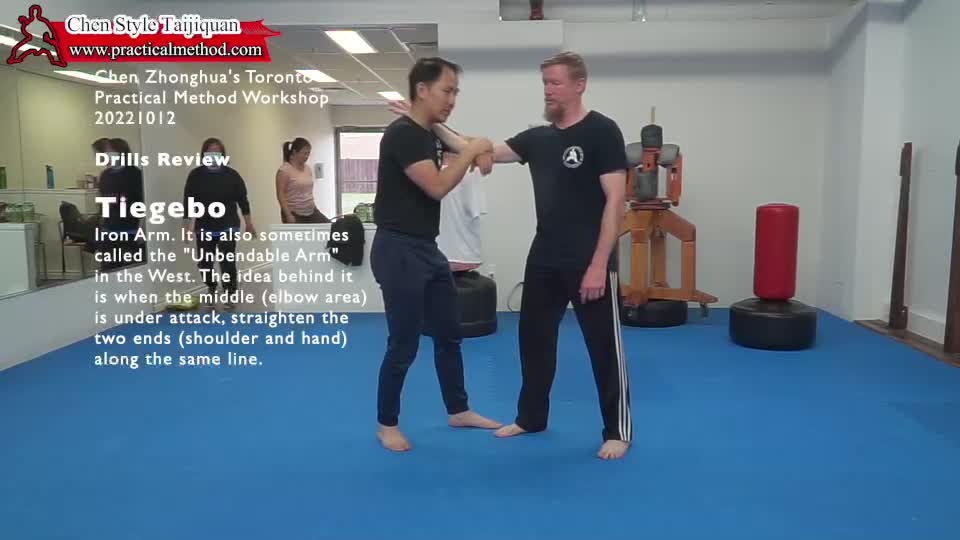
Presenter: Chen Zhonghua Length: 0 mins Difficulty: 3/5 Language: English
Year: 2022 Location: Edmonton, Canada
If you like this video, there is an even greater value in purchasing one of the packages below.
Purchase Theory-Body Part Video Package
Purchase Training-Basic Moves Video Package 1-2022
Purchase Toronto Practical Method Private Class 20221012 Video Package
NOTE:
- Video packages are designed for the convenience of students.
- Some packages are in fact classifications of videos.
- Some videos in packages might have been published and purchased by you individually.
- Average prices of videos in packages are considerably lower than individual videos. The number of videos in the package will increase until the sum of all individual video prices equal to two times or more of the package price.
- In view of this, if you have purchased a video that are also included in a package your have purchased, or vice versa, we will not give refunds or equivalents.
- All videos in packages are paid videos. They are restricted to your personal viewing and other usage. You do not have copyright of the videos and therefore you do not have permission to give/share with others.
- Please note that as a customer/user of the website and/or student of Chen Zhonghua, you have given him and the companies/organizations he represents permission to use videos or photos with you, both personally and commercially.
- Making a paid purchase constitutes agreement to the above terms.



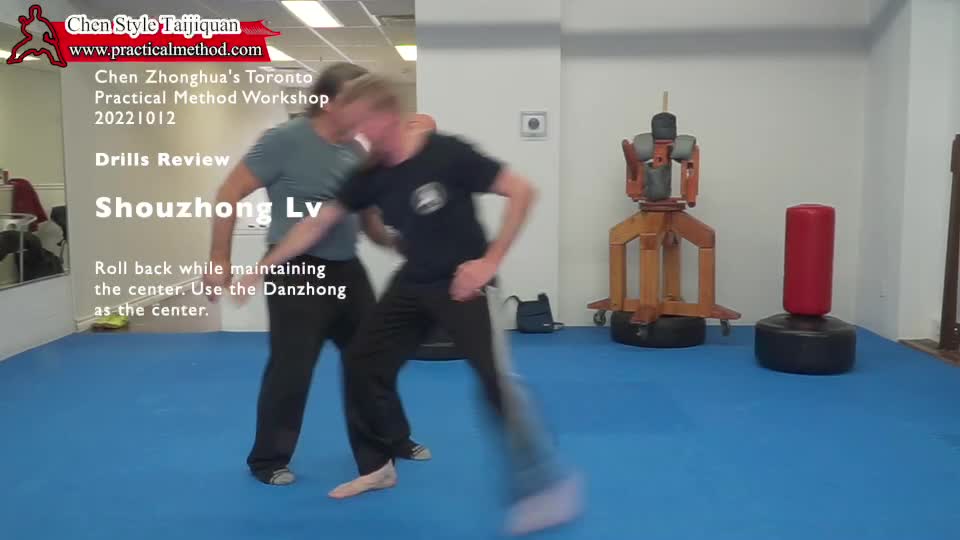
Presenter: Chen Zhonghua Length: 0 mins Difficulty: 3/5 Language: English
Year: 2022 Location: Edmonton, Canada
If you like this video, there is an even greater value in purchasing one of the packages below.
Purchase Theory-Concepts Video Package 1
Purchase Toronto Practical Method Private Class 20221012 Video Package
NOTE:
- Video packages are designed for the convenience of students.
- Some packages are in fact classifications of videos.
- Some videos in packages might have been published and purchased by you individually.
- Average prices of videos in packages are considerably lower than individual videos. The number of videos in the package will increase until the sum of all individual video prices equal to two times or more of the package price.
- In view of this, if you have purchased a video that are also included in a package your have purchased, or vice versa, we will not give refunds or equivalents.
- All videos in packages are paid videos. They are restricted to your personal viewing and other usage. You do not have copyright of the videos and therefore you do not have permission to give/share with others.
- Please note that as a customer/user of the website and/or student of Chen Zhonghua, you have given him and the companies/organizations he represents permission to use videos or photos with you, both personally and commercially.
- Making a paid purchase constitutes agreement to the above terms.



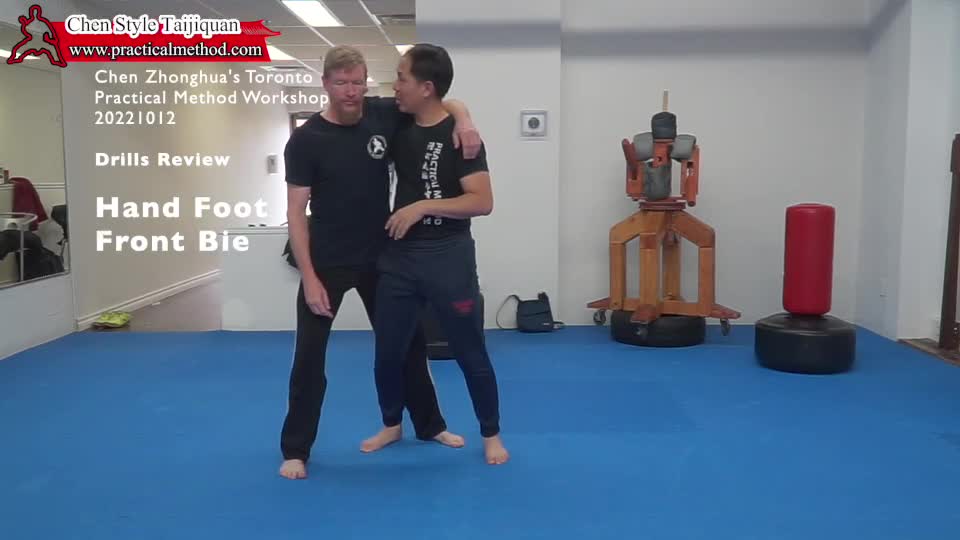
Presenter: Chen Zhonghua Length: 0 mins Difficulty: 3/5 Language: English
Year: 2022 Location: Edmonton, Canada
If you like this video, there is an even greater value in purchasing one of the packages below.
Purchase Theory-Concepts Video Package 1
Purchase Toronto Practical Method Private Class 20221012 Video Package
NOTE:
- Video packages are designed for the convenience of students.
- Some packages are in fact classifications of videos.
- Some videos in packages might have been published and purchased by you individually.
- Average prices of videos in packages are considerably lower than individual videos. The number of videos in the package will increase until the sum of all individual video prices equal to two times or more of the package price.
- In view of this, if you have purchased a video that are also included in a package your have purchased, or vice versa, we will not give refunds or equivalents.
- All videos in packages are paid videos. They are restricted to your personal viewing and other usage. You do not have copyright of the videos and therefore you do not have permission to give/share with others.
- Please note that as a customer/user of the website and/or student of Chen Zhonghua, you have given him and the companies/organizations he represents permission to use videos or photos with you, both personally and commercially.
- Making a paid purchase constitutes agreement to the above terms.


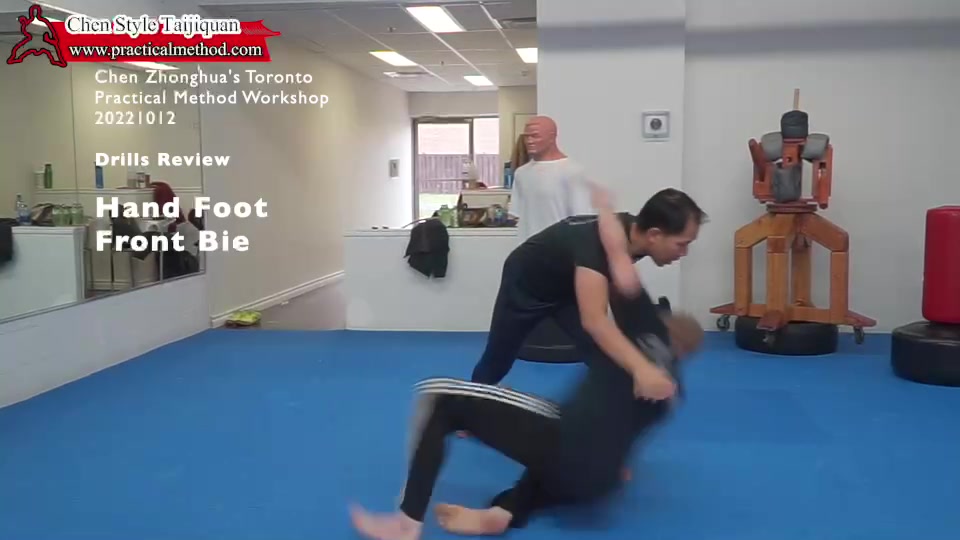
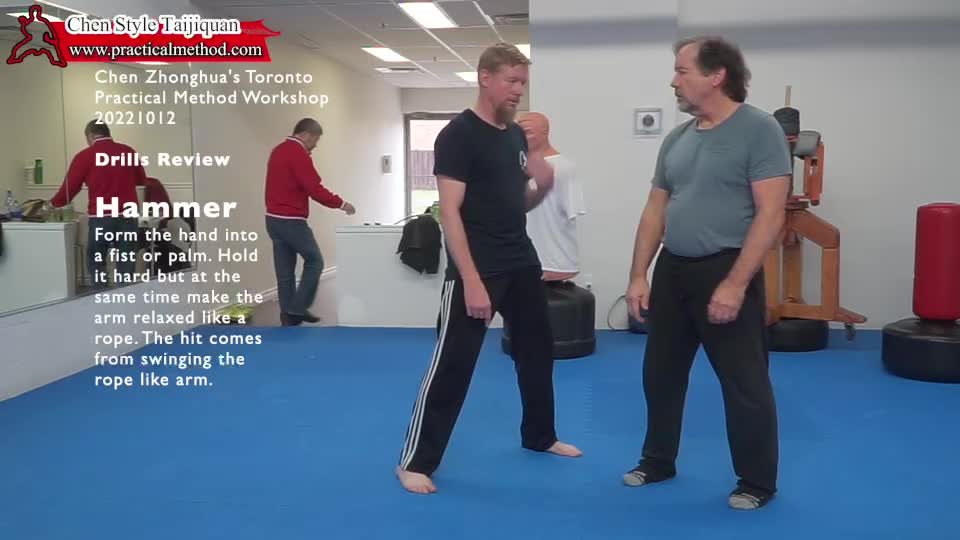
Presenter: Chen Zhonghua Length: 0 mins Difficulty: 3/5 Language: English
Year: 2022 Location: Edmonton, Canada
If you like this video, there is an even greater value in purchasing one of the packages below.
Purchase Toronto Practical Method Private Class 20221012 Video Package
NOTE:
- Video packages are designed for the convenience of students.
- Some packages are in fact classifications of videos.
- Some videos in packages might have been published and purchased by you individually.
- Average prices of videos in packages are considerably lower than individual videos. The number of videos in the package will increase until the sum of all individual video prices equal to two times or more of the package price.
- In view of this, if you have purchased a video that are also included in a package your have purchased, or vice versa, we will not give refunds or equivalents.
- All videos in packages are paid videos. They are restricted to your personal viewing and other usage. You do not have copyright of the videos and therefore you do not have permission to give/share with others.
- Please note that as a customer/user of the website and/or student of Chen Zhonghua, you have given him and the companies/organizations he represents permission to use videos or photos with you, both personally and commercially.
- Making a paid purchase constitutes agreement to the above terms.

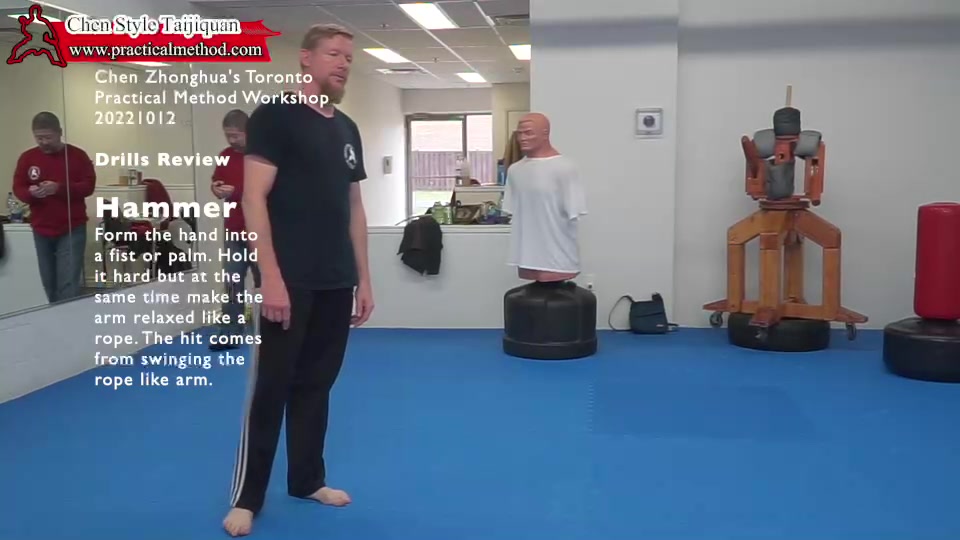

Presenter: Chen Zhonghua Length: 1 mins Difficulty: 3/5 Language: English
Year: 2022 Location: Edmonton, Canada
If you like this video, there is an even greater value in purchasing one of the packages below.
Purchase Toronto Practical Method Private Class 20221012 Video Package
Purchase Chen Zhonghua Taiji Academy Trailers Video Package 2
NOTE:
- Video packages are designed for the convenience of students.
- Some packages are in fact classifications of videos.
- Some videos in packages might have been published and purchased by you individually.
- Average prices of videos in packages are considerably lower than individual videos. The number of videos in the package will increase until the sum of all individual video prices equal to two times or more of the package price.
- In view of this, if you have purchased a video that are also included in a package your have purchased, or vice versa, we will not give refunds or equivalents.
- All videos in packages are paid videos. They are restricted to your personal viewing and other usage. You do not have copyright of the videos and therefore you do not have permission to give/share with others.
- Please note that as a customer/user of the website and/or student of Chen Zhonghua, you have given him and the companies/organizations he represents permission to use videos or photos with you, both personally and commercially.
- Making a paid purchase constitutes agreement to the above terms.




Presenter: Chen Zhonghua Length: 8 mins Difficulty: 3/5 Language: English
Year: 2022 Location: Edmonton, Canada
If you like this video, there is an even greater value in purchasing one of the packages below.
Purchase Toronto Practical Method Private Class 20221012 Video Package
NOTE:
- Video packages are designed for the convenience of students.
- Some packages are in fact classifications of videos.
- Some videos in packages might have been published and purchased by you individually.
- Average prices of videos in packages are considerably lower than individual videos. The number of videos in the package will increase until the sum of all individual video prices equal to two times or more of the package price.
- In view of this, if you have purchased a video that are also included in a package your have purchased, or vice versa, we will not give refunds or equivalents.
- All videos in packages are paid videos. They are restricted to your personal viewing and other usage. You do not have copyright of the videos and therefore you do not have permission to give/share with others.
- Please note that as a customer/user of the website and/or student of Chen Zhonghua, you have given him and the companies/organizations he represents permission to use videos or photos with you, both personally and commercially.
- Making a paid purchase constitutes agreement to the above terms.

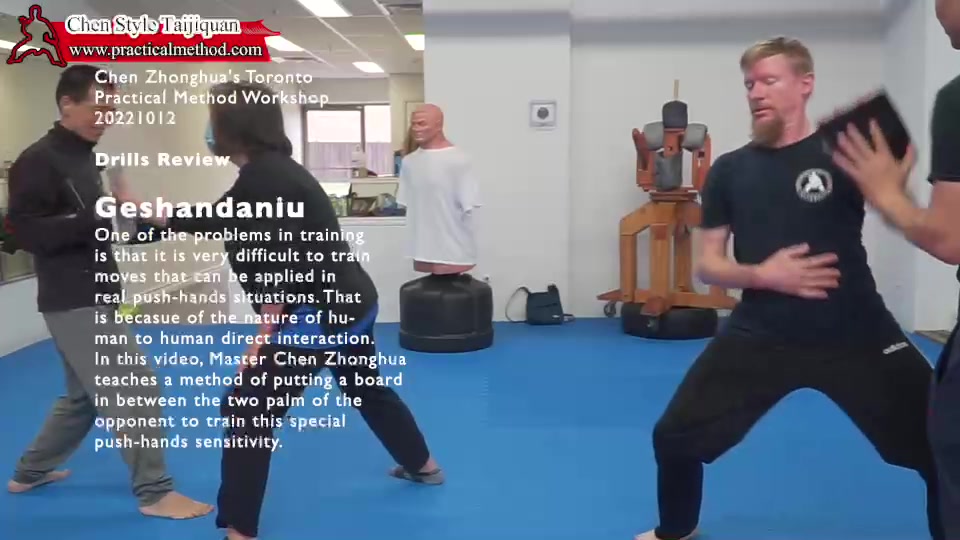


Presenter: Chen Zhonghua Length: 0 mins Difficulty: 3/5 Language: English
Year: 2022 Location: Edmonton, Canada
If you like this video, there is an even greater value in purchasing one of the packages below.
Purchase Toronto Practical Method Private Class 20221012 Video Package
NOTE:
- Video packages are designed for the convenience of students.
- Some packages are in fact classifications of videos.
- Some videos in packages might have been published and purchased by you individually.
- Average prices of videos in packages are considerably lower than individual videos. The number of videos in the package will increase until the sum of all individual video prices equal to two times or more of the package price.
- In view of this, if you have purchased a video that are also included in a package your have purchased, or vice versa, we will not give refunds or equivalents.
- All videos in packages are paid videos. They are restricted to your personal viewing and other usage. You do not have copyright of the videos and therefore you do not have permission to give/share with others.
- Please note that as a customer/user of the website and/or student of Chen Zhonghua, you have given him and the companies/organizations he represents permission to use videos or photos with you, both personally and commercially.
- Making a paid purchase constitutes agreement to the above terms.




Presenter: Chen Zhonghua Length: 0 mins Difficulty: 3/5 Language: English
Year: 2022 Location: Edmonton, Canada
If you like this video, there is an even greater value in purchasing one of the packages below.
Purchase Theory-Body Part Video Package
Purchase Toronto Practical Method Private Class 20221012 Video Package
NOTE:
- Video packages are designed for the convenience of students.
- Some packages are in fact classifications of videos.
- Some videos in packages might have been published and purchased by you individually.
- Average prices of videos in packages are considerably lower than individual videos. The number of videos in the package will increase until the sum of all individual video prices equal to two times or more of the package price.
- In view of this, if you have purchased a video that are also included in a package your have purchased, or vice versa, we will not give refunds or equivalents.
- All videos in packages are paid videos. They are restricted to your personal viewing and other usage. You do not have copyright of the videos and therefore you do not have permission to give/share with others.
- Please note that as a customer/user of the website and/or student of Chen Zhonghua, you have given him and the companies/organizations he represents permission to use videos or photos with you, both personally and commercially.
- Making a paid purchase constitutes agreement to the above terms.




Presenter: Chen Zhonghua Length: 0 mins Difficulty: 3/5 Language: English
Year: 2022 Location: Edmonton, Canada
If you like this video, there is an even greater value in purchasing one of the packages below.
Purchase Theory-Body Part Video Package
Purchase Toronto Practical Method Private Class 20221012 Video Package
NOTE:
- Video packages are designed for the convenience of students.
- Some packages are in fact classifications of videos.
- Some videos in packages might have been published and purchased by you individually.
- Average prices of videos in packages are considerably lower than individual videos. The number of videos in the package will increase until the sum of all individual video prices equal to two times or more of the package price.
- In view of this, if you have purchased a video that are also included in a package your have purchased, or vice versa, we will not give refunds or equivalents.
- All videos in packages are paid videos. They are restricted to your personal viewing and other usage. You do not have copyright of the videos and therefore you do not have permission to give/share with others.
- Please note that as a customer/user of the website and/or student of Chen Zhonghua, you have given him and the companies/organizations he represents permission to use videos or photos with you, both personally and commercially.
- Making a paid purchase constitutes agreement to the above terms.


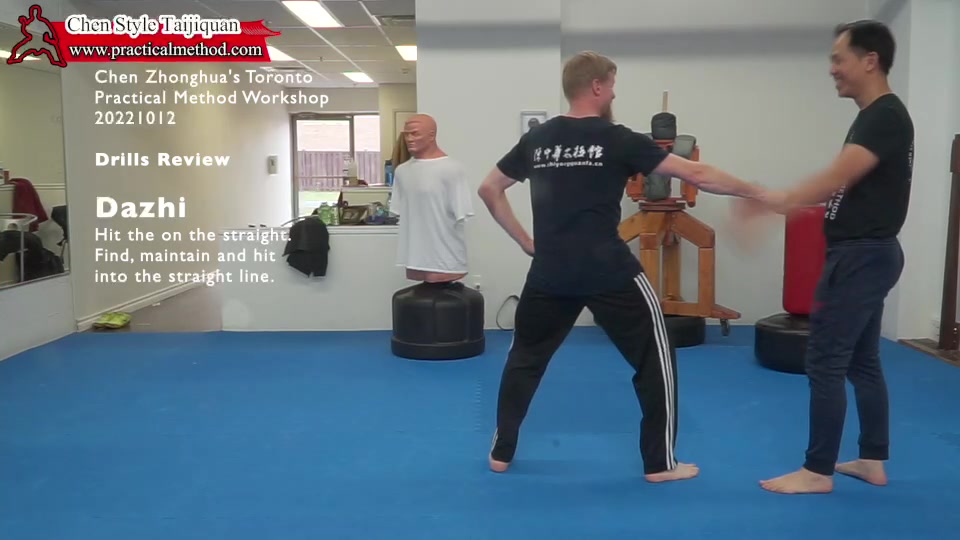

Presenter: Chen Zhonghua Length: 1 mins Difficulty: 3/5 Language: English
Year: 2022 Location: Edmonton, Canada
If you like this video, there is an even greater value in purchasing one of the packages below.
Purchase Theory-Body Part Video Package
Purchase Toronto Practical Method Private Class 20221012 Video Package
NOTE:
- Video packages are designed for the convenience of students.
- Some packages are in fact classifications of videos.
- Some videos in packages might have been published and purchased by you individually.
- Average prices of videos in packages are considerably lower than individual videos. The number of videos in the package will increase until the sum of all individual video prices equal to two times or more of the package price.
- In view of this, if you have purchased a video that are also included in a package your have purchased, or vice versa, we will not give refunds or equivalents.
- All videos in packages are paid videos. They are restricted to your personal viewing and other usage. You do not have copyright of the videos and therefore you do not have permission to give/share with others.
- Please note that as a customer/user of the website and/or student of Chen Zhonghua, you have given him and the companies/organizations he represents permission to use videos or photos with you, both personally and commercially.
- Making a paid purchase constitutes agreement to the above terms.
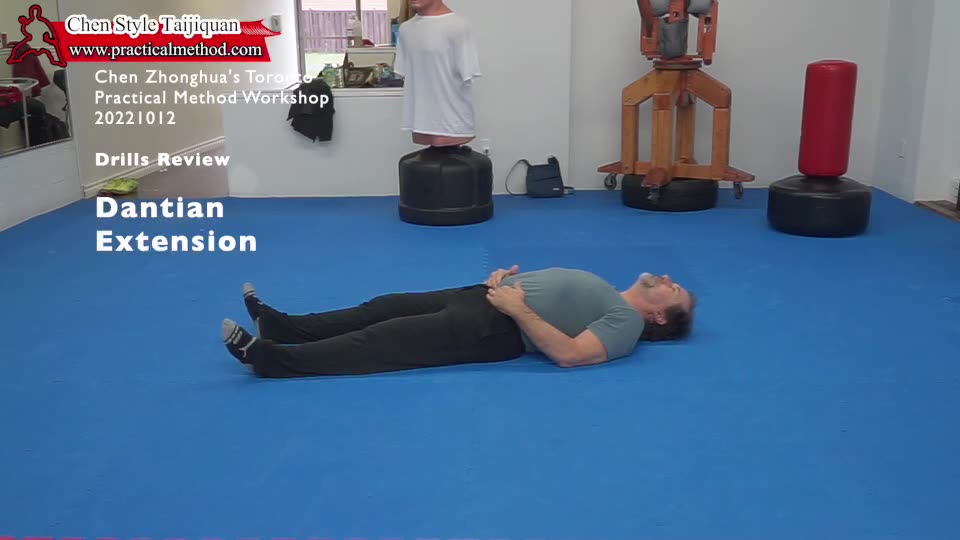



Presenter: Chen Zhonghua Length: 3 mins Difficulty: 3/5 Language: English
Year: 2022 Location: Edmonton, Canada
The full video can be purchased below:
"Chen Zhonghua Online Lesson 20221110" Online Video Purchase
If you like this video, there is an even greater value in purchasing one of the packages below.
Purchase Training-Basic Moves Video Package 1-2022
Purchase Toronto Practical Method Private Class 20221012 Video Package
NOTE:
- Video packages are designed for the convenience of students.
- Some packages are in fact classifications of videos.
- Some videos in packages might have been published and purchased by you individually.
- Average prices of videos in packages are considerably lower than individual videos. The number of videos in the package will increase until the sum of all individual video prices equal to two times or more of the package price.
- In view of this, if you have purchased a video that are also included in a package your have purchased, or vice versa, we will not give refunds or equivalents.
- All videos in packages are paid videos. They are restricted to your personal viewing and other usage. You do not have copyright of the videos and therefore you do not have permission to give/share with others.
- Please note that as a customer/user of the website and/or student of Chen Zhonghua, you have given him and the companies/organizations he represents permission to use videos or photos with you, both personally and commercially.
- Making a paid purchase constitutes agreement to the above terms.


Presenter: Chen Zhonghua Length: 24 mins Difficulty: 3/5 Language: English
Year: 2022 Location: Edmonton, Canada
If you like this video, there is an even greater value in purchasing one of the packages below.
Purchase Toronto Practical Method Private Class 20221012 Video Package
NOTE:
- Video packages are designed for the convenience of students.
- Some packages are in fact classifications of videos.
- Some videos in packages might have been published and purchased by you individually.
- Average prices of videos in packages are considerably lower than individual videos. The number of videos in the package will increase until the sum of all individual video prices equal to two times or more of the package price.
- In view of this, if you have purchased a video that are also included in a package your have purchased, or vice versa, we will not give refunds or equivalents.
- All videos in packages are paid videos. They are restricted to your personal viewing and other usage. You do not have copyright of the videos and therefore you do not have permission to give/share with others.
- Please note that as a customer/user of the website and/or student of Chen Zhonghua, you have given him and the companies/organizations he represents permission to use videos or photos with you, both personally and commercially.
- Making a paid purchase constitutes agreement to the above terms.
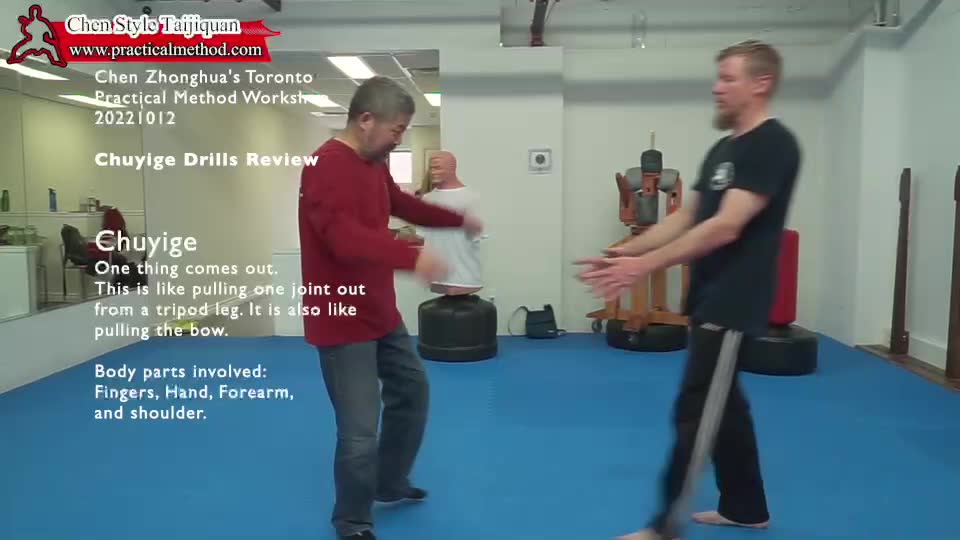



Presenter: Chen Zhonghua Length: 0 mins Difficulty: 3/5 Language: English
Year: 2022 Location: Edmonton, Canada
The full video can be purchased below:
"Chen Zhonghua Online Lesson 20221110" Online Video Purchase
If you like this video, there is an even greater value in purchasing one of the packages below.
Purchase 2022 Full Year Online Class Video Package
Purchase Theory-Body Part Video Package
NOTE:
- Video packages are designed for the convenience of students.
- Some packages are in fact classifications of videos.
- Some videos in packages might have been published and purchased by you individually.
- Average prices of videos in packages are considerably lower than individual videos. The number of videos in the package will increase until the sum of all individual video prices equal to two times or more of the package price.
- In view of this, if you have purchased a video that are also included in a package your have purchased, or vice versa, we will not give refunds or equivalents.
- All videos in packages are paid videos. They are restricted to your personal viewing and other usage. You do not have copyright of the videos and therefore you do not have permission to give/share with others.
- Please note that as a customer/user of the website and/or student of Chen Zhonghua, you have given him and the companies/organizations he represents permission to use videos or photos with you, both personally and commercially.
- Making a paid purchase constitutes agreement to the above terms.




Presenter: Chen Zhonghua Length: 5 mins Difficulty: 3/5 Language: English
Year: 2022 Location: Edmonton, Canada
The full video can be purchased below:
"Chen Zhonghua English Instructor Class 20220930" Online Video Purchase
If you like this video, there is an even greater value in purchasing one of the packages below.
Purchase Theory-Concepts Video Package 1
Purchase 2022 English Instructor Class Video Package
NOTE:
- Video packages are designed for the convenience of students.
- Some packages are in fact classifications of videos.
- Some videos in packages might have been published and purchased by you individually.
- Average prices of videos in packages are considerably lower than individual videos. The number of videos in the package will increase until the sum of all individual video prices equal to two times or more of the package price.
- In view of this, if you have purchased a video that are also included in a package your have purchased, or vice versa, we will not give refunds or equivalents.
- All videos in packages are paid videos. They are restricted to your personal viewing and other usage. You do not have copyright of the videos and therefore you do not have permission to give/share with others.
- Please note that as a customer/user of the website and/or student of Chen Zhonghua, you have given him and the companies/organizations he represents permission to use videos or photos with you, both personally and commercially.
- Making a paid purchase constitutes agreement to the above terms.



Presenter: Chen Zhonghua Length: 3 mins Difficulty: 3/5 Language: English
Year: 2022 Location: Edmonton, Canada
The full video can be purchased below:
"Chen Zhonghua English Instructor Class 20221007" Online Video Purchase
If you like this video, there is an even greater value in purchasing one of the packages below.
Purchase Theory-Concepts Video Package 1
Purchase Theory-Body Part Video Package
Purchase 2022 English Instructor Class Video Package
NOTE:
- Video packages are designed for the convenience of students.
- Some packages are in fact classifications of videos.
- Some videos in packages might have been published and purchased by you individually.
- Average prices of videos in packages are considerably lower than individual videos. The number of videos in the package will increase until the sum of all individual video prices equal to two times or more of the package price.
- In view of this, if you have purchased a video that are also included in a package your have purchased, or vice versa, we will not give refunds or equivalents.
- All videos in packages are paid videos. They are restricted to your personal viewing and other usage. You do not have copyright of the videos and therefore you do not have permission to give/share with others.
- Please note that as a customer/user of the website and/or student of Chen Zhonghua, you have given him and the companies/organizations he represents permission to use videos or photos with you, both personally and commercially.
- Making a paid purchase constitutes agreement to the above terms.


Presenter: Chen Zhonghua Length: 3 mins Difficulty: 3/5 Language: English
Year: 2022 Location: Edmonton, Canada
The full video can be purchased below:
"Chen Zhonghua English Instructor Class 20220916" Online Video Purchase
If you like this video, there is an even greater value in purchasing one of the packages below.
Purchase Theory-Concepts Video Package 1
Purchase 2022 English Instructor Class Video Package
NOTE:
- Video packages are designed for the convenience of students.
- Some packages are in fact classifications of videos.
- Some videos in packages might have been published and purchased by you individually.
- Average prices of videos in packages are considerably lower than individual videos. The number of videos in the package will increase until the sum of all individual video prices equal to two times or more of the package price.
- In view of this, if you have purchased a video that are also included in a package your have purchased, or vice versa, we will not give refunds or equivalents.
- All videos in packages are paid videos. They are restricted to your personal viewing and other usage. You do not have copyright of the videos and therefore you do not have permission to give/share with others.
- Please note that as a customer/user of the website and/or student of Chen Zhonghua, you have given him and the companies/organizations he represents permission to use videos or photos with you, both personally and commercially.
- Making a paid purchase constitutes agreement to the above terms.


Presenter: Chen Zhonghua Length: 0 mins Difficulty: 3/5 Language: English
Year: 2022 Location: Edmonton, Canada
The full video can be purchased below:
"Chen Zhonghua English Instructor Class 20220923" Online Video Purchase
If you like this video, there is an even greater value in purchasing one of the packages below.
Purchase 2022 English Instructor Class Video Package
NOTE:
- Video packages are designed for the convenience of students.
- Some packages are in fact classifications of videos.
- Some videos in packages might have been published and purchased by you individually.
- Average prices of videos in packages are considerably lower than individual videos. The number of videos in the package will increase until the sum of all individual video prices equal to two times or more of the package price.
- In view of this, if you have purchased a video that are also included in a package your have purchased, or vice versa, we will not give refunds or equivalents.
- All videos in packages are paid videos. They are restricted to your personal viewing and other usage. You do not have copyright of the videos and therefore you do not have permission to give/share with others.
- Please note that as a customer/user of the website and/or student of Chen Zhonghua, you have given him and the companies/organizations he represents permission to use videos or photos with you, both personally and commercially.
- Making a paid purchase constitutes agreement to the above terms.
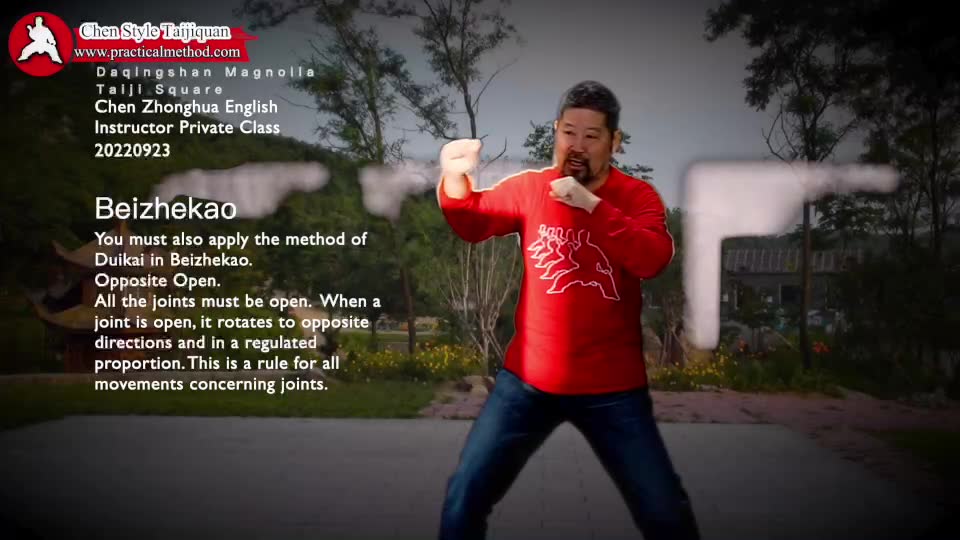



Presenter: Chen Zhonghua Length: 4 mins Difficulty: 3/5 Language: English
Year: 2022 Location: Edmonton, Canada
The full video can be purchased below:
"Chen Zhonghua English Instructor Class 20220923" Online Video Purchase
If you like this video, there is an even greater value in purchasing one of the packages below.
Purchase 2022 English Instructor Class Video Package
NOTE:
- Video packages are designed for the convenience of students.
- Some packages are in fact classifications of videos.
- Some videos in packages might have been published and purchased by you individually.
- Average prices of videos in packages are considerably lower than individual videos. The number of videos in the package will increase until the sum of all individual video prices equal to two times or more of the package price.
- In view of this, if you have purchased a video that are also included in a package your have purchased, or vice versa, we will not give refunds or equivalents.
- All videos in packages are paid videos. They are restricted to your personal viewing and other usage. You do not have copyright of the videos and therefore you do not have permission to give/share with others.
- Please note that as a customer/user of the website and/or student of Chen Zhonghua, you have given him and the companies/organizations he represents permission to use videos or photos with you, both personally and commercially.
- Making a paid purchase constitutes agreement to the above terms.


Presenter: Chen Zhonghua Length: 3 mins Difficulty: 3/5 Language: English
Year: 2022 Location: Toronto, Canada
The full video can be purchased below:
"Chen Zhonghua Online Lesson 20220811" Online Video Purchase
If you like this video, there is an even greater value in purchasing one of the packages below.
Purchase Theory-Concepts Video Package 1
Purchase 2022 Full Year Online Class Video Package
NOTE:
- Video packages are designed for the convenience of students.
- Some packages are in fact classifications of videos.
- Some videos in packages might have been published and purchased by you individually.
- Average prices of videos in packages are considerably lower than individual videos. The number of videos in the package will increase until the sum of all individual video prices equal to two times or more of the package price.
- In view of this, if you have purchased a video that are also included in a package your have purchased, or vice versa, we will not give refunds or equivalents.
- All videos in packages are paid videos. They are restricted to your personal viewing and other usage. You do not have copyright of the videos and therefore you do not have permission to give/share with others.
- Please note that as a customer/user of the website and/or student of Chen Zhonghua, you have given him and the companies/organizations he represents permission to use videos or photos with you, both personally and commercially.
- Making a paid purchase constitutes agreement to the above terms.


Presenter: Chen Zhonghua Length: 1 mins Difficulty: 3/5 Language: English
Year: 2022 Location: Edmonton, Canada
The full video can be purchased below:
"Chen Zhonghua Online Lesson 20221019" Online Video Purchase
If you like this video, there is an even greater value in purchasing one of the packages below.
Purchase 2022 Full Year Online Class Video Package
NOTE:
- Video packages are designed for the convenience of students.
- Some packages are in fact classifications of videos.
- Some videos in packages might have been published and purchased by you individually.
- Average prices of videos in packages are considerably lower than individual videos. The number of videos in the package will increase until the sum of all individual video prices equal to two times or more of the package price.
- In view of this, if you have purchased a video that are also included in a package your have purchased, or vice versa, we will not give refunds or equivalents.
- All videos in packages are paid videos. They are restricted to your personal viewing and other usage. You do not have copyright of the videos and therefore you do not have permission to give/share with others.
- Please note that as a customer/user of the website and/or student of Chen Zhonghua, you have given him and the companies/organizations he represents permission to use videos or photos with you, both personally and commercially.
- Making a paid purchase constitutes agreement to the above terms.




Presenter: Chen Zhonghua Length: 0 mins Difficulty: 3/5 Language: English
Year: 2022 Location: Edmonton, Canada
The full video can be purchased below:
"Chen Zhonghua Online Lesson 20221005" Online Video Purchase
If you like this video, there is an even greater value in purchasing one of the packages below.
Purchase 2022 Full Year Online Class Video Package
Purchase Theory-Body Part Video Package
NOTE:
- Video packages are designed for the convenience of students.
- Some packages are in fact classifications of videos.
- Some videos in packages might have been published and purchased by you individually.
- Average prices of videos in packages are considerably lower than individual videos. The number of videos in the package will increase until the sum of all individual video prices equal to two times or more of the package price.
- In view of this, if you have purchased a video that are also included in a package your have purchased, or vice versa, we will not give refunds or equivalents.
- All videos in packages are paid videos. They are restricted to your personal viewing and other usage. You do not have copyright of the videos and therefore you do not have permission to give/share with others.
- Please note that as a customer/user of the website and/or student of Chen Zhonghua, you have given him and the companies/organizations he represents permission to use videos or photos with you, both personally and commercially.
- Making a paid purchase constitutes agreement to the above terms.




Presenter: Chen Zhonghua Length: 1 mins Difficulty: 3/5 Language: English
Year: 2022 Location: Edmonton, Canada
The full video can be purchased below:
"Chen Zhonghua Online Lesson 20221005" Online Video Purchase
If you like this video, there is an even greater value in purchasing one of the packages below.
Purchase 2022 Full Year Online Class Video Package
Purchase Theory-Body Part Video Package
NOTE:
- Video packages are designed for the convenience of students.
- Some packages are in fact classifications of videos.
- Some videos in packages might have been published and purchased by you individually.
- Average prices of videos in packages are considerably lower than individual videos. The number of videos in the package will increase until the sum of all individual video prices equal to two times or more of the package price.
- In view of this, if you have purchased a video that are also included in a package your have purchased, or vice versa, we will not give refunds or equivalents.
- All videos in packages are paid videos. They are restricted to your personal viewing and other usage. You do not have copyright of the videos and therefore you do not have permission to give/share with others.
- Please note that as a customer/user of the website and/or student of Chen Zhonghua, you have given him and the companies/organizations he represents permission to use videos or photos with you, both personally and commercially.
- Making a paid purchase constitutes agreement to the above terms.




Presenter: Chen Zhonghua Length: 0 mins Difficulty: 3/5 Language: English
Year: 2022 Location: Edmonton, Canada
The full video can be purchased below:
"Chen Zhonghua Online Lesson 20221005" Online Video Purchase
If you like this video, there is an even greater value in purchasing one of the packages below.
Purchase 2022 Full Year Online Class Video Package
NOTE:
- Video packages are designed for the convenience of students.
- Some packages are in fact classifications of videos.
- Some videos in packages might have been published and purchased by you individually.
- Average prices of videos in packages are considerably lower than individual videos. The number of videos in the package will increase until the sum of all individual video prices equal to two times or more of the package price.
- In view of this, if you have purchased a video that are also included in a package your have purchased, or vice versa, we will not give refunds or equivalents.
- All videos in packages are paid videos. They are restricted to your personal viewing and other usage. You do not have copyright of the videos and therefore you do not have permission to give/share with others.
- Please note that as a customer/user of the website and/or student of Chen Zhonghua, you have given him and the companies/organizations he represents permission to use videos or photos with you, both personally and commercially.
- Making a paid purchase constitutes agreement to the above terms.




Presenter: Chen Zhonghua Length: 1 mins Difficulty: 3/5 Language: English
Year: 2022 Location: Toronto, Canada
If you like this video, there is an even greater value in purchasing one of the packages below.
Purchase Theory-Body Part Video Package
Purchase Toronto Practical Method Private Class 20221012 Video Package
NOTE:
- Video packages are designed for the convenience of students.
- Some packages are in fact classifications of videos.
- Some videos in packages might have been published and purchased by you individually.
- Average prices of videos in packages are considerably lower than individual videos. The number of videos in the package will increase until the sum of all individual video prices equal to two times or more of the package price.
- In view of this, if you have purchased a video that are also included in a package your have purchased, or vice versa, we will not give refunds or equivalents.
- All videos in packages are paid videos. They are restricted to your personal viewing and other usage. You do not have copyright of the videos and therefore you do not have permission to give/share with others.
- Please note that as a customer/user of the website and/or student of Chen Zhonghua, you have given him and the companies/organizations he represents permission to use videos or photos with you, both personally and commercially.
- Making a paid purchase constitutes agreement to the above terms.
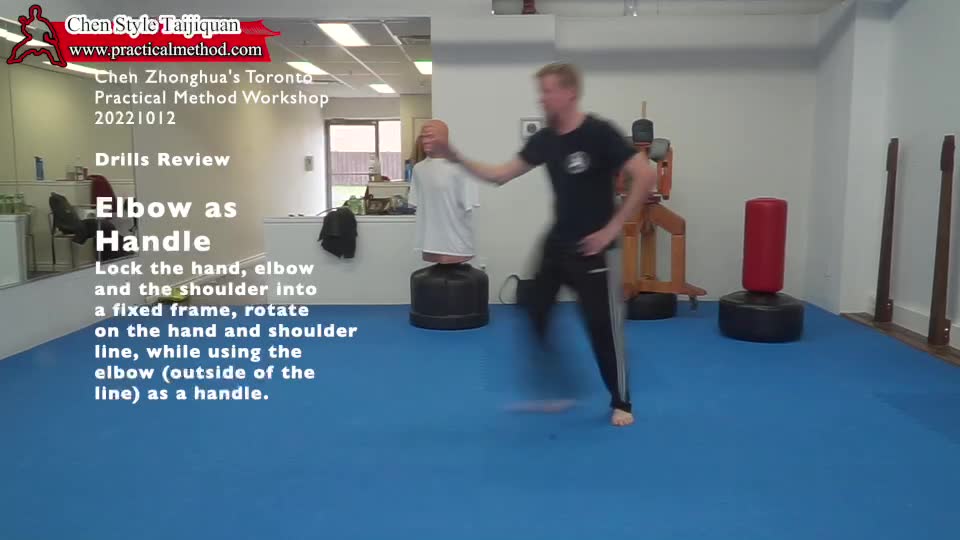
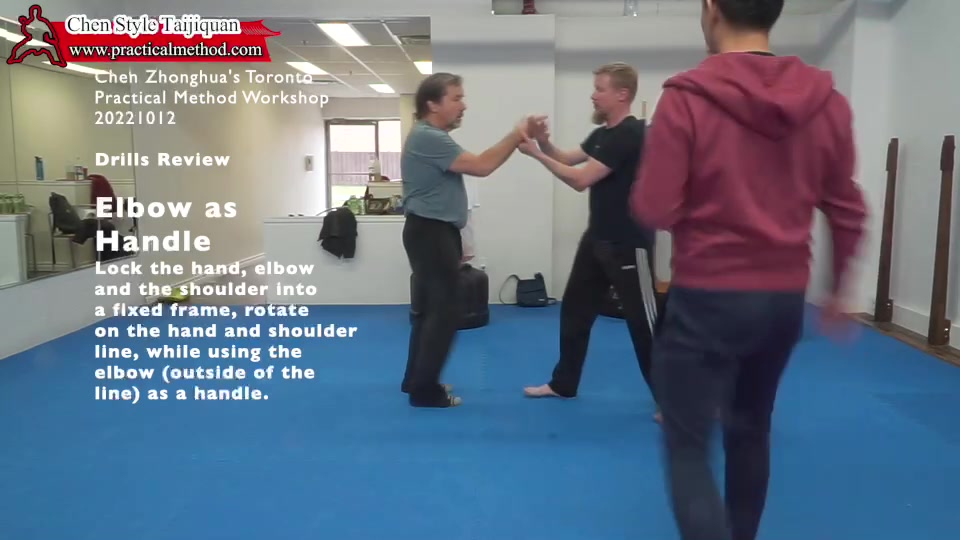


Presenter: Chen Zhonghua Length: 2 mins Difficulty: 3/5 Language: English
Year: 2022 Location: Edmonton, Canada
The full video can be purchased below:
"Chen Zhonghua Online Lesson 20221005" Online Video Purchase
If you like this video, there is an even greater value in purchasing one of the packages below.
Purchase Theory-Concepts Video Package 1
Purchase 2022 Full Year Online Class Video Package
NOTE:
- Video packages are designed for the convenience of students.
- Some packages are in fact classifications of videos.
- Some videos in packages might have been published and purchased by you individually.
- Average prices of videos in packages are considerably lower than individual videos. The number of videos in the package will increase until the sum of all individual video prices equal to two times or more of the package price.
- In view of this, if you have purchased a video that are also included in a package your have purchased, or vice versa, we will not give refunds or equivalents.
- All videos in packages are paid videos. They are restricted to your personal viewing and other usage. You do not have copyright of the videos and therefore you do not have permission to give/share with others.
- Please note that as a customer/user of the website and/or student of Chen Zhonghua, you have given him and the companies/organizations he represents permission to use videos or photos with you, both personally and commercially.
- Making a paid purchase constitutes agreement to the above terms.
Presenter: Chen Zhonghua Length: 0 mins Difficulty: 3/5 Language: English
Year: 2022 Location: Toronto, Canada
If you like this video, there is an even greater value in purchasing one of the packages below.
Purchase Theory-Concepts Video Package 1
Purchase Theory-Body Part Video Package
Purchase Toronto Practical Method Private Class 20221012 Video Package
Purchase Chen Zhonghua Taiji Academy Trailers Video Package 2
NOTE:
- Video packages are designed for the convenience of students.
- Some packages are in fact classifications of videos.
- Some videos in packages might have been published and purchased by you individually.
- Average prices of videos in packages are considerably lower than individual videos. The number of videos in the package will increase until the sum of all individual video prices equal to two times or more of the package price.
- In view of this, if you have purchased a video that are also included in a package your have purchased, or vice versa, we will not give refunds or equivalents.
- All videos in packages are paid videos. They are restricted to your personal viewing and other usage. You do not have copyright of the videos and therefore you do not have permission to give/share with others.
- Please note that as a customer/user of the website and/or student of Chen Zhonghua, you have given him and the companies/organizations he represents permission to use videos or photos with you, both personally and commercially.
- Making a paid purchase constitutes agreement to the above terms.



Presenter: Chen Zhonghua Length: 0 mins Difficulty: 3/5 Language: English
Year: 2022 Location: Toronto, Canada
If you like this video, there is an even greater value in purchasing one of the packages below.
Purchase Theory-Concepts Video Package 1
Purchase Theory-Body Part Video Package
Purchase Toronto Practical Method Private Class 20221012 Video Package
Purchase Chen Zhonghua Taiji Academy Trailers Video Package 2
NOTE:
- Video packages are designed for the convenience of students.
- Some packages are in fact classifications of videos.
- Some videos in packages might have been published and purchased by you individually.
- Average prices of videos in packages are considerably lower than individual videos. The number of videos in the package will increase until the sum of all individual video prices equal to two times or more of the package price.
- In view of this, if you have purchased a video that are also included in a package your have purchased, or vice versa, we will not give refunds or equivalents.
- All videos in packages are paid videos. They are restricted to your personal viewing and other usage. You do not have copyright of the videos and therefore you do not have permission to give/share with others.
- Please note that as a customer/user of the website and/or student of Chen Zhonghua, you have given him and the companies/organizations he represents permission to use videos or photos with you, both personally and commercially.
- Making a paid purchase constitutes agreement to the above terms.




Presenter: Chen Zhonghua Length: 0 mins Difficulty: 3/5 Language: English
Year: 2022 Location: Toronto, Canada
If you like this video, there is an even greater value in purchasing one of the packages below.
Purchase Theory-Concepts Video Package 1
Purchase Theory-Body Part Video Package
Purchase Toronto Practical Method Private Class 20221012 Video Package
NOTE:
- Video packages are designed for the convenience of students.
- Some packages are in fact classifications of videos.
- Some videos in packages might have been published and purchased by you individually.
- Average prices of videos in packages are considerably lower than individual videos. The number of videos in the package will increase until the sum of all individual video prices equal to two times or more of the package price.
- In view of this, if you have purchased a video that are also included in a package your have purchased, or vice versa, we will not give refunds or equivalents.
- All videos in packages are paid videos. They are restricted to your personal viewing and other usage. You do not have copyright of the videos and therefore you do not have permission to give/share with others.
- Please note that as a customer/user of the website and/or student of Chen Zhonghua, you have given him and the companies/organizations he represents permission to use videos or photos with you, both personally and commercially.
- Making a paid purchase constitutes agreement to the above terms.




Presenter: Chen Zhonghua Length: 10 mins Difficulty: 3/5 Language: English
Year: 2022 Location: Toronto, Canada
If you like this video, there is an even greater value in purchasing one of the packages below.
Purchase Theory-Concepts Video Package 1
Purchase Toronto Practical Method Private Class 20221012 Video Package
NOTE:
- Video packages are designed for the convenience of students.
- Some packages are in fact classifications of videos.
- Some videos in packages might have been published and purchased by you individually.
- Average prices of videos in packages are considerably lower than individual videos. The number of videos in the package will increase until the sum of all individual video prices equal to two times or more of the package price.
- In view of this, if you have purchased a video that are also included in a package your have purchased, or vice versa, we will not give refunds or equivalents.
- All videos in packages are paid videos. They are restricted to your personal viewing and other usage. You do not have copyright of the videos and therefore you do not have permission to give/share with others.
- Please note that as a customer/user of the website and/or student of Chen Zhonghua, you have given him and the companies/organizations he represents permission to use videos or photos with you, both personally and commercially.
- Making a paid purchase constitutes agreement to the above terms.




Presenter: Chen Zhonghua Length: 0 mins Difficulty: 3/5 Language: English
Year: 2022 Location: Edmonton, Canada
The full video can be purchased below:
"Chen Zhonghua Online Lesson 20220929" Online Video Purchase
If you like this video, there is an even greater value in purchasing one of the packages below.
Purchase Theory-Concepts Video Package 1
Purchase 2022 Full Year Online Class Video Package
NOTE:
- Video packages are designed for the convenience of students.
- Some packages are in fact classifications of videos.
- Some videos in packages might have been published and purchased by you individually.
- Average prices of videos in packages are considerably lower than individual videos. The number of videos in the package will increase until the sum of all individual video prices equal to two times or more of the package price.
- In view of this, if you have purchased a video that are also included in a package your have purchased, or vice versa, we will not give refunds or equivalents.
- All videos in packages are paid videos. They are restricted to your personal viewing and other usage. You do not have copyright of the videos and therefore you do not have permission to give/share with others.
- Please note that as a customer/user of the website and/or student of Chen Zhonghua, you have given him and the companies/organizations he represents permission to use videos or photos with you, both personally and commercially.
- Making a paid purchase constitutes agreement to the above terms.




Presenter: Chen Zhonghua Length: 10 mins Difficulty: 3/5 Language: English
Year: 2022 Location: Toronto, Canada
If you like this video, there is an even greater value in purchasing one of the packages below.
Purchase Theory-Concepts Video Package 1
Purchase Toronto Practical Method Private Class 20221012 Video Package
NOTE:
- Video packages are designed for the convenience of students.
- Some packages are in fact classifications of videos.
- Some videos in packages might have been published and purchased by you individually.
- Average prices of videos in packages are considerably lower than individual videos. The number of videos in the package will increase until the sum of all individual video prices equal to two times or more of the package price.
- In view of this, if you have purchased a video that are also included in a package your have purchased, or vice versa, we will not give refunds or equivalents.
- All videos in packages are paid videos. They are restricted to your personal viewing and other usage. You do not have copyright of the videos and therefore you do not have permission to give/share with others.
- Please note that as a customer/user of the website and/or student of Chen Zhonghua, you have given him and the companies/organizations he represents permission to use videos or photos with you, both personally and commercially.
- Making a paid purchase constitutes agreement to the above terms.



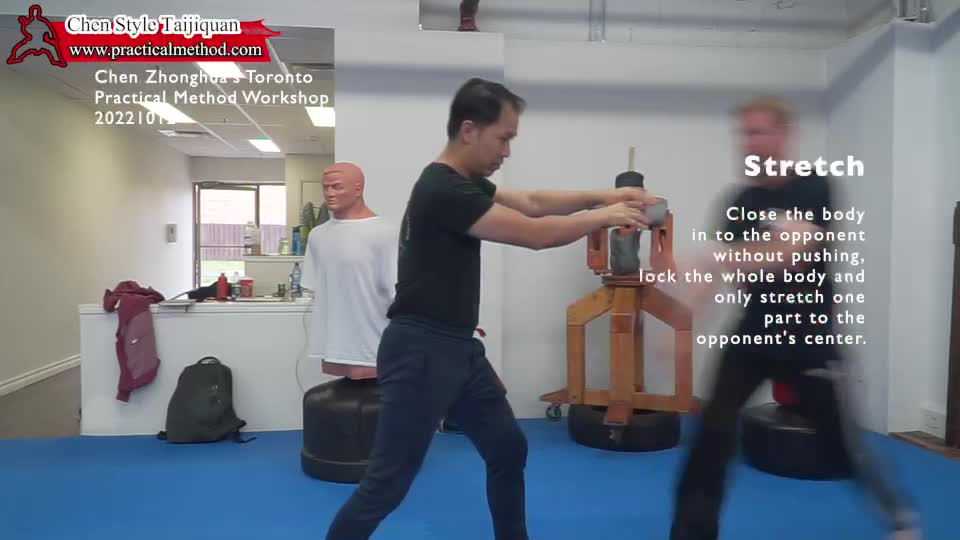
Presenter: Chen Zhonghua Length: 10 mins Difficulty: 3/5 Language: English
Year: 2022 Location: Toronto, Canada
If you like this video, there is an even greater value in purchasing one of the packages below.
Purchase Theory-Concepts Video Package 1
Purchase Toronto Practical Method Private Class 20221012 Video Package
NOTE:
- Video packages are designed for the convenience of students.
- Some packages are in fact classifications of videos.
- Some videos in packages might have been published and purchased by you individually.
- Average prices of videos in packages are considerably lower than individual videos. The number of videos in the package will increase until the sum of all individual video prices equal to two times or more of the package price.
- In view of this, if you have purchased a video that are also included in a package your have purchased, or vice versa, we will not give refunds or equivalents.
- All videos in packages are paid videos. They are restricted to your personal viewing and other usage. You do not have copyright of the videos and therefore you do not have permission to give/share with others.
- Please note that as a customer/user of the website and/or student of Chen Zhonghua, you have given him and the companies/organizations he represents permission to use videos or photos with you, both personally and commercially.
- Making a paid purchase constitutes agreement to the above terms.





